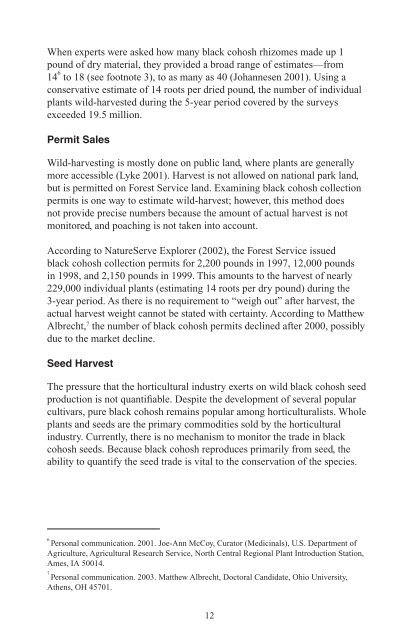Black Cohosh - Non-Timber Forest Products
Black Cohosh - Non-Timber Forest Products
Black Cohosh - Non-Timber Forest Products
You also want an ePaper? Increase the reach of your titles
YUMPU automatically turns print PDFs into web optimized ePapers that Google loves.
When experts were asked how many black cohosh rhizomes made up 1<br />
pound of dry material, they provided a broad range of estimates—from<br />
14 6 to 18 (see footnote 3), to as many as 40 (Johannesen 2001). Using a<br />
conservative estimate of 14 roots per dried pound, the number of individual<br />
plants wild-harvested during the 5-year period covered by the surveys<br />
exceeded 19.5 million.<br />
Permit Sales<br />
Wild-harvesting is mostly done on public land, where plants are generally<br />
more accessible (Lyke 2001). Harvest is not allowed on national park land,<br />
but is permitted on <strong>Forest</strong> Service land. Examining black cohosh collection<br />
permits is one way to estimate wild-harvest; however, this method does<br />
not provide precise numbers because the amount of actual harvest is not<br />
monitored, and poaching is not taken into account.<br />
According to NatureServe Explorer (2002), the <strong>Forest</strong> Service issued<br />
black cohosh collection permits for 2,200 pounds in 1997, 12,000 pounds<br />
in 1998, and 2,150 pounds in 1999. This amounts to the harvest of nearly<br />
229,000 individual plants (estimating 14 roots per dry pound) during the<br />
3-year period. As there is no requirement to “weigh out” after harvest, the<br />
actual harvest weight cannot be stated with certainty. According to Matthew<br />
Albrecht, 7 the number of black cohosh permits declined after 2000, possibly<br />
due to the market decline.<br />
Seed Harvest<br />
The pressure that the horticultural industry exerts on wild black cohosh seed<br />
production is not quantifiable. Despite the development of several popular<br />
cultivars, pure black cohosh remains popular among horticulturalists. Whole<br />
plants and seeds are the primary commodities sold by the horticultural<br />
industry. Currently, there is no mechanism to monitor the trade in black<br />
cohosh seeds. Because black cohosh reproduces primarily from seed, the<br />
ability to quantify the seed trade is vital to the conservation of the species.<br />
6<br />
Personal communication. 2001. Joe-Ann McCoy, Curator (Medicinals), U.S. Department of<br />
Agriculture, Agricultural Research Service, North Central Regional Plant Introduction Station,<br />
Ames, IA 50014.<br />
7 Personal communication. 2003. Matthew Albrecht, Doctoral Candidate, Ohio University,<br />
Athens, OH 45701.<br />
12


